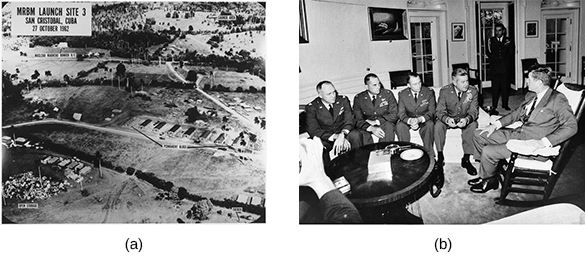| << Chapter < Page | Chapter >> Page > |
Kennedy agreed to support the previous administration’s plans, and on April 17, 1961, approximately fourteen hundred Cuban exiles stormed ashore at the designated spot. However, Kennedy feared domestic criticism and worried about Soviet retaliation elsewhere in the world, such as Berlin. He cancelled the anticipated air support, which enabled the Cuban army to easily defeat the insurgents. The hoped-for uprising of the Cuban people also failed to occur. The surviving members of the exile army were taken into custody.
The Bay of Pigs invasion was a major foreign policy disaster for President Kennedy and highlighted Cuba’s military vulnerability to the Castro administration. The following year, the Soviet Union sent troops and technicians to Cuba to strengthen its new ally against further U.S. military plots. Then, on October 14, U.S. spy planes took aerial photographs that confirmed the presence of long-range ballistic missile sites in Cuba. The United States was now within easy reach of Soviet nuclear warheads ( [link] ).

On October 22, Kennedy demanded that Soviet premier Nikita Khrushchev remove the missiles. He also ordered a naval quarantine placed around Cuba to prevent Soviet ships from approaching. Despite his use of the word “quarantine” instead of “blockade,” for a blockade was considered an act of war, a potential war with the Soviet Union was nevertheless on the president’s mind. As U.S. ships headed for Cuba, the army was told to prepare for war, and Kennedy appeared on national television to declare his intention to defend the Western Hemisphere from Soviet aggression.
The world held its breath awaiting the Soviet reply. Realizing how serious the United States was, Khrushchev sought a peaceful solution to the crisis, overruling those in his government who urged a harder stance. Behind the scenes, Robert Kennedy and Soviet ambassador Anatoly Dobrynin worked toward a compromise that would allow both superpowers to back down without either side’s seeming intimidated by the other. On October 26, Khrushchev agreed to remove the Russian missiles in exchange for Kennedy’s promise not to invade Cuba. On October 27, Kennedy’s agreement was made public, and the crisis ended. Not made public, but nevertheless part of the agreement, was Kennedy’s promise to remove U.S. warheads from Turkey, as close to Soviet targets as the Cuban missiles had been to American ones.
The showdown between the United States and the Soviet Union over Cuba’s missiles had put the world on the brink of a nuclear war. Both sides already had long-range bombers with nuclear weapons airborne or ready for launch, and were only hours away from the first strike. In the long run, this nearly catastrophic example of nuclear brinksmanship ended up making the world safer. A telephone “hot line” was installed, linking Washington and Moscow to avert future crises, and in 1963, Kennedy and Khrushchev signed the Limited Test Ban Treaty, prohibiting tests of nuclear weapons in Earth’s atmosphere.

Notification Switch
Would you like to follow the 'U.s. history' conversation and receive update notifications?